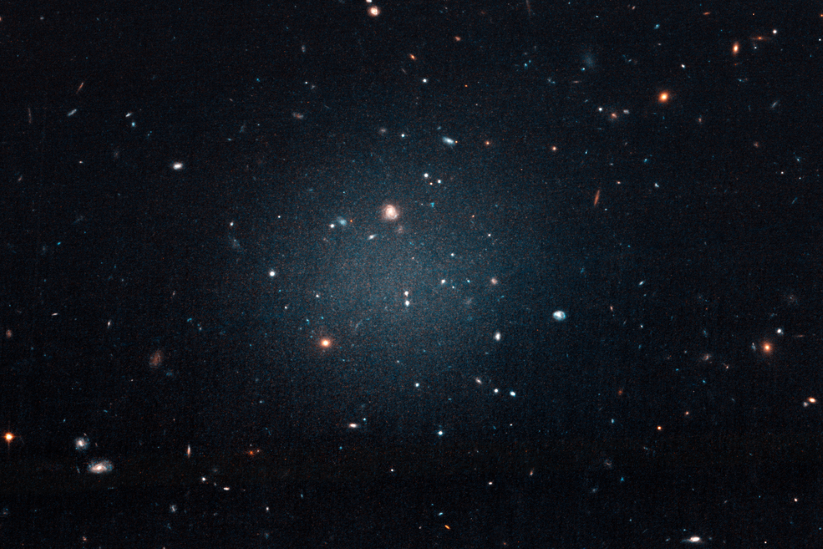 An "impossible" galaxy without dark matter. As we see, the impossible is possibleDark matter
An "impossible" galaxy without dark matter. As we see, the impossible is possibleDark matter , despite the fact that people write and speak about it everywhere and everywhere, is only a hypothetical form of matter. According to one hypothesis, now generally accepted, it does not emit electromagnetic radiation and does not directly interact with it. As a result, dark matter is difficult to directly detect using methods that are used by humans. Nevertheless, there are methods of indirect detection - for example, by the gravitational influence on nearby objects. The elucidation of the nature of dark matter, according to astronomers, allows us to solve the problem of hidden mass, which, in particular, lies in the anomalously high speed of rotation of the outer regions of galaxies.
Dark matter has a gravitational effect, sometimes very strong, on the behavior of stars, their clusters and other objects. That is how this mysterious form of matter is discovered by scientists (if, of course, it is really dark matter). At the moment, signs of the existence of dark matter have been found in almost all detected and studied galaxies. But recently, astronomers have discovered a galaxy in which, apparently, there is no this form of matter. Why? Nobody knows.
They found the galaxy
completely by accident , largely due to the fact that it behaved differently than it should if it were “normal”. Found it with the help of
Dragonfly Array , a host of small telescopes designed to detect weak objects emitting a minimum of light. While observing the group of galaxies NGC 1052, it was this group of telescopes that “spotted” an object that had previously been seen in this part of the sky.
“We noticed it, because there is a rather strong difference in how it appeared before Dragonfly Array and its reflection in the data of the Sloan Digital Sky Survey,” said the authors of the study on the “bright galaxy”. The object was a diffuse element with some structures inside.
Detailed observation of it with the help of the Hubble and the 10-meter Keck telescope made it possible to see some details of the image of the object, called NGC1052 – DF2. As it turned out, it is a galaxy belonging to the newly discovered class of ultra-diffuse galaxies. This type of galaxy is like a bubble through which you can see everything that is behind it.
Such galaxies were discovered repeatedly, though infrequently in some galactic clusters. Some of them interacted with neighboring galaxies, giving them their own stars and gas and dust structures. But here the dark matter remained with them, so it can be said that some diffuse galaxies received “enrichment” by dark matter.
In order to find out what is happening with the NGC1052 – DF2 object, the researchers used the Keck telescope to obtain images of the structures inside this galaxy. This work allowed, in particular, to calculate the mass of the galaxy.
It turned out that the mass of NGC1052 – DF2 is extremely low for the galaxy itself - just 10 to 8 degrees of the mass of the Sun. Using data on the luminosity of the galaxy, scientists found that the stars in it are about the same - 10 to 8 degrees. That is, in fact, all the stars and the mass of the galaxy "in sight". Usually galaxies are heavier than the aggregate of masses of their stars, which makes it possible to judge the presence of dark matter. But not in the case of NGC1052 – DF2.
According to astronomers, all this can only say one thing - that NGC1052 – DF2 is either very poor in dark matter, or this mysterious substance in the galaxy is not at all. The most interesting thing is that most models of the Universe and its objects, built by scientists, provide for the presence of dark matter. And the galaxy, which is deprived of it, requires a special relation to itself - the calculations must be done anew, taking into account the lack of “overhang”.
How did the galaxy form without dark matter? One of the assumptions is that NGC1052 – DF2 was formed from matter ejected by quasars. Maybe it was originally a gas cloud the size of a galaxy and a high concentration of gas, which made it possible to start the process of forming stars and, in fact, the galaxy itself.
Now scientists are busy studying the features of the structure of the galaxy, trying to understand what makes NGC1052 – DF2 different from “normal” galaxies, including the one in which we live.